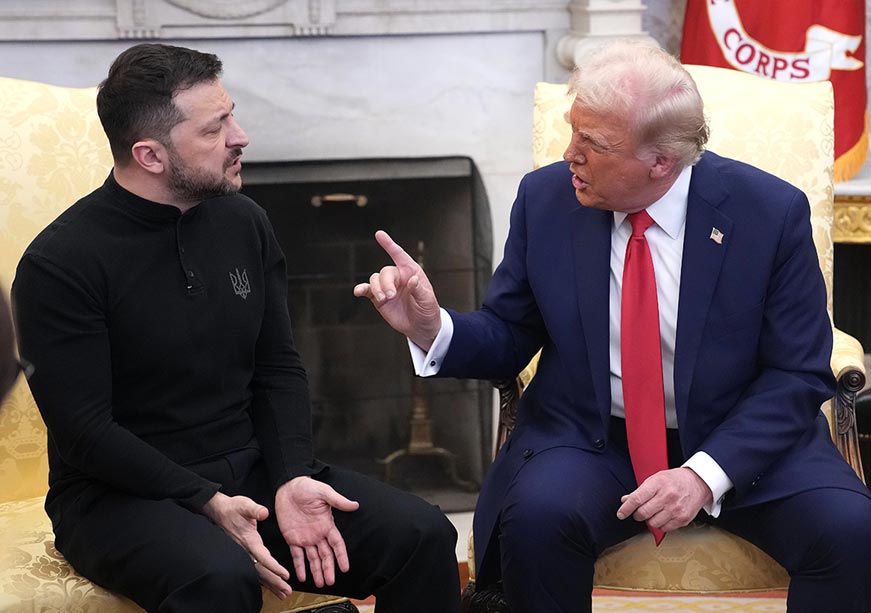-
CENTRES
Progammes & Centres
Location
US involvement in Ukraine’s critical mineral sector may not have a compelling economic rationale, but it justifies further US involvement in Ukraine and the post-war reconstruction of the country

Image Source: Getty
The global demand for critical minerals has increased significantly over the last decade, as they are the fundamental building blocks for modern industrial technology, military applications and renewable energy. In recent years, the price of the same has skyrocketed because of the increasing global demand for advanced technologies. This has resulted in nations scrambling for new markets to ensure an uninterrupted supply of critical minerals. One of them is Ukraine, Europe’s largest country, which is said to have 5% of the world’s critical minerals reserves.
The deal grants the US privileged access to Kyiv’s minerals and the creation of a joint investment fund from the income generated from mineral resources, a part of which would be used for the reconstruction of Ukraine.
The Trump administration has expressed considerable interest in Ukraine's minerals, signing the US-Ukraine critical minerals agreement, after months of negotiations on the 30th of April. The deal grants the US privileged access to Kyiv’s minerals and the creation of a joint investment fund from the income generated from mineral resources, a part of which would be used for the reconstruction of Ukraine. For Kyiv, this deal is a lifeline in ensuring continued American aid. With the agreement now in place, key questions remain about its strategic rationale—and whether its implementation is feasible amid ongoing geopolitical challenges.
Ukraine currently has critical minerals valued at $14 trillion, and has documented more than 20,000 mineral deposits covering more than 116 types of minerals. The country has vast manganese resources (in the Nikopol basin) and Titanium (in the Zhitomir and Dnipro regions). Ukraine has reserves of uranium (in Kirovohrad oblast), coal, iron ore, zirconium, graphite, and lithium. Additionally, Kyiv has reserves of several rare earth elements such as lanthanum, neodymium, yttrium, and cerium, which are essential in the production of electric vehicles, wind turbines, electronic components, laser guidance systems and satellites. The majority of the rare earths in Ukraine are situated within the Ukrainian shield, a geological structure covering the Central and Northern regions of the country. However, these resources have not been sufficiently studied or developed, but their potential is high.
The majority of the rare earths in Ukraine are situated within the Ukrainian shield, a geological structure covering the Central and Northern regions of the country.
In 2021, before Russia invaded Ukraine, the metals and mining industry contributed 10% of Ukraine's GDP and constituted 33% of its exports. However, it is unclear how much of this revenue is generated from exporting rare earths and critical minerals. Since the invasion, the minerals supply chains have seen disruptions, especially in the high technology and defence sectors. Close to 50% of semiconductor-grade neon came from Ukraine, the export of which ceased after the war began.
It is in Washington’s interests to build a resilient minerals supply chain. At present, Beijing has a global dominance in the critical minerals supply and value chains. The West have a comparative advantage in manufacturing advanced semiconductors and critical technology. In recent years, in light of the growing Chinese belligerence, Western countries began imposing export control regulations on China to hinder China’s technological development, especially in the defence sector. In response, Beijing has imposed restrictions and banned the export of critical minerals and rare earths. Thus, Washington is looking for new sources of critical minerals.
The initial deal went against Ukrainian interests and included no security guarantees and included a debt burden, where Ukraine would have to pay for US military aid recieved under the Biden administration.
The US expressed interest in investing in Ukraine's critical minerals industry even before the Trump administration took office. According to the US Geological Survey, Ukraine has 22 of the 50 minerals classified as critical minerals. The initial deal went against Ukrainian interests and included no security guarantees and included a debt burden, where Ukraine would have to pay for US military aid recieved under the Biden administration. After lengthy negotiations, Ukraine was able to negotiate for certain concessions, where Ukraine has greater agency on allowing/denying extraction, freed Ukraine from a debt obligation, and allowed Ukraine to receive continued US assistance. Under the deal, Washington would exclusively finance mineral, oil, and gas projects, as well as infrastructure and processing in Ukraine.
At present, Ukraine does not have any commercially operational rare earth mines. It is important to distinguish between reserves and resources. The former refers to deposits that can be extracted, and the latter refers to minerals available on the ground. The average time taken to ascertain the mineral's commercial viability takes between 10 and 12 years, and 16 years to extract the mineral after exploration. Thus, there will be no short or medium-term gains for the US or Ukraine. Moreover, even with large reserves, Ukraine does not necessarily have a comparative advantage in the global minerals supply chain. For instance, in the case of uranium, Ukraine has 3% of recoverable reserves, while Australia has 28% of the global uranium reserves, Kazakhstan has 13%, Canada has 10% and Niger has 5%. Similarly, even in other minerals such as graphite and titanium, there are competitive markets in Brazil, Australia, and Southeast African countries.
Another complicated factor is the status and management of critical mineral deposits in the Russian-occupied regions of Donetsk, Luhansk, Kherson, and Zaporizhzhia.
Further, the assessments conducted on Ukraine’s minerals date back to Soviet times, and no recent exploration has been undertaken. Lastly, another complicated factor is the status and management of critical mineral deposits in the Russian-occupied regions of Donetsk, Luhansk, Kherson, and Zaporizhzhia. Even though Russian President Vladimir Putin suggested offering mineral exploration deals to the US in Eastern Ukraine, getting private businesses to invest in a region without international recognition, not to mention under sanctions, will be difficult. Thus, US involvement in Ukraine’s critical mineral sector may have a weaker economic rationale, but it justifies further US involvement in Ukraine and the post-war reconstruction of the country.
This commentary originally appeared in Moneycontrol.
The views expressed above belong to the author(s). ORF research and analyses now available on Telegram! Click here to access our curated content — blogs, longforms and interviews.

Rajoli Siddharth Jayaprakash is a Junior Fellow with the ORF Strategic Studies programme, focusing on Russia’s foreign policy and economy, and India-Russia relations. Siddharth is a ...
Read More +